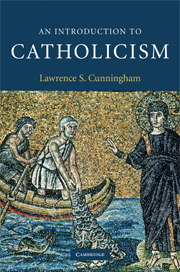Book contents
- Frontmatter
- Contents
- Illustrations
- Preface
- Acknowledgments
- 1 The many meanings of Catholicism
- 2 Roman Catholicism
- 3 Being Catholic: Some typologies
- 4 Catholicism in place and time
- 5 Catholic worship
- 6 The rule of faith
- 7 Catholic spirituality
- 8 The missionary character of Catholicism
- 9 Catholic reformation(s)
- 10 The moral life
- 11 The contemporary Catholic Church
- 12 Reading Catholicism: Bibliographical resources
- Index
- References
12 - Reading Catholicism: Bibliographical resources
Published online by Cambridge University Press: 05 June 2012
- Frontmatter
- Contents
- Illustrations
- Preface
- Acknowledgments
- 1 The many meanings of Catholicism
- 2 Roman Catholicism
- 3 Being Catholic: Some typologies
- 4 Catholicism in place and time
- 5 Catholic worship
- 6 The rule of faith
- 7 Catholic spirituality
- 8 The missionary character of Catholicism
- 9 Catholic reformation(s)
- 10 The moral life
- 11 The contemporary Catholic Church
- 12 Reading Catholicism: Bibliographical resources
- Index
- References
Summary
INTRODUCTION
The English verb “to read” derives etymologically from the Middle English reden, which can mean, variously, to interpret, to inquire, as well as to read in the modern sense. We hearken back to the older senses of the word “read” when we “read the situation” or “read the look on her face,” etc. Similarly, there are many ways in which we can “read” Catholicism as we have insisted in this work. We can “read” its architecture, art, worship, holy persons, popes, prayer life, its sacraments and sacramentals, and so on. Each time we attempt to get a “read” on such things, we are confronted with implicit intentions (Why do Catholics build cathedrals?); symbols (Why does that painting include a crown on the head of the Virgin Mary?); usages (What are holy-water founts for at the entrance of Catholic churches?); and sheer puzzlement (What do monks have to do with the teachings of Jesus?); etc. Such a range of topics may help to explain why it is that when a person writes the words “Roman Catholicism” into a search engine on a computer, the “hits” number in the millions.
It has been the conviction of this work that Catholicism is fundamentally both simple (a way of following Jesus Christ and his teachings) and bafflingly complex. The complexity, of course, at least in part, is due to its long history and its tendency to treasure its traditions.
- Type
- Chapter
- Information
- An Introduction to Catholicism , pp. 269 - 275Publisher: Cambridge University PressPrint publication year: 2009

